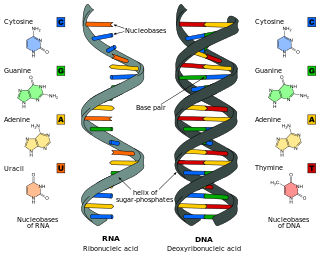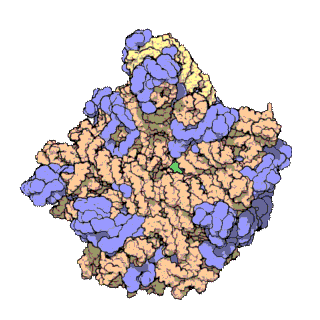Related Research Articles

Nucleic acids are biopolymers, macromolecules, essential to all known forms of life. They are composed of nucleotides, which are the monomers made of three components: a 5-carbon sugar, a phosphate group and a nitrogenous base. The two main classes of nucleic acids are deoxyribonucleic acid (DNA) and ribonucleic acid (RNA). If the sugar is ribose, the polymer is RNA; if the sugar is the ribose derivative deoxyribose, the polymer is DNA.

Ribonucleic acid (RNA) is a polymeric molecule essential in various biological roles in coding, decoding, regulation and expression of genes. RNA and deoxyribonucleic acid (DNA) are nucleic acids. Along with lipids, proteins, and carbohydrates, nucleic acids constitute one of the four major macromolecules essential for all known forms of life. Like DNA, RNA is assembled as a chain of nucleotides, but unlike DNA, RNA is found in nature as a single strand folded onto itself, rather than a paired double strand. Cellular organisms use messenger RNA (mRNA) to convey genetic information that directs synthesis of specific proteins. Many viruses encode their genetic information using an RNA genome.

Biophysics is an interdisciplinary science that applies approaches and methods traditionally used in physics to study biological phenomena. Biophysics covers all scales of biological organization, from molecular to organismic and populations. Biophysical research shares significant overlap with biochemistry, molecular biology, physical chemistry, physiology, nanotechnology, bioengineering, computational biology, biomechanics, developmental biology and systems biology.

In molecular biology, a reading frame is a way of dividing the sequence of nucleotides in a nucleic acid molecule into a set of consecutive, non-overlapping triplets. Where these triplets equate to amino acids or stop signals during translation, they are called codons.
B. Montgomery "Monte" Pettitt is the Director of the Sealy Center for Structural Biology and Molecular Biophysics at University of Texas Medical Branch in Galveston, Texas, holder of the Robert A. Welch Distinguished Chair in Chemistry, and tenured Professor in the Department of Biochemistry and Molecular Biology, as well as the department of Pharmacology and Toxicology. He is also affiliated with and former director of The W. M. Keck Center at Rice University, and a faculty member of the Structural and Computational Biology and Molecular Biophysics program at Baylor College of Medicine. At the University of Houston, he was the Hugh Roy and Lille Cranz Cullen Distinguished Professor of Chemistry and Robert A. Welch Chair in Chemistry, as well as the director of its Institute for Molecular Design.

In molecular biology, the term double helix refers to the structure formed by double-stranded molecules of nucleic acids such as DNA. The double helical structure of a nucleic acid complex arises as a consequence of its secondary structure, and is a fundamental component in determining its tertiary structure. The term entered popular culture with the publication in 1968 of The Double Helix: A Personal Account of the Discovery of the Structure of DNA by James Watson.

Nucleoproteins are proteins conjugated with nucleic acids. Typical nucleoproteins include ribosomes, nucleosomes and viral nucleocapsid proteins.
GRE Subject Biochemistry, Cell and Molecular Biology was a standardized exam provided by ETS that was discontinued in December 2016. It is a paper-based exam and there are no computer-based versions of it. ETS places this exam three times per year: once in April, once in October and once in November. Some graduate programs in the United States recommend taking this exam, while others require this exam score as a part of the application to their graduate programs. ETS sends a bulletin with a sample practice test to each candidate after registration for the exam. There are 180 questions within the biochemistry subject test.
Alexander Rich was an American biologist and biophysicist. He was the William Thompson Sedgwick Professor of Biophysics at MIT and Harvard Medical School. Dr. Rich earned both an A.B. and an M.D. from Harvard University. He was a post-doc of Linus Pauling along with James Watson. During this time he was a member of the RNA Tie Club, a social and discussion group which attacked the question of how DNA encodes proteins. He had over 600 publications to his name.

Roger David Kornberg is an American biochemist and professor of structural biology at Stanford University School of Medicine. Kornberg was awarded the Nobel Prize in Chemistry in 2006 for his studies of the process by which genetic information from DNA is copied to RNA, "the molecular basis of eukaryotic transcription."

Molecular biophysics is a rapidly evolving interdisciplinary area of research that combines concepts in physics, chemistry, engineering, mathematics and biology. It seeks to understand biomolecular systems and explain biological function in terms of molecular structure, structural organization, and dynamic behaviour at various levels of complexity. This discipline covers topics such as the measurement of molecular forces, molecular associations, allosteric interactions, Brownian motion, and cable theory. Additional areas of study can be found on Outline of Biophysics. The discipline has required development of specialized equipment and procedures capable of imaging and manipulating minute living structures, as well as novel experimental approaches.
Marie Weaver is an American artist who specializes in ceramic sculpture, printmaking, book arts, and graphic design. Weaver earned a B. A. from the University of Vermont and a Master of Fine Arts degree from Syracuse University. Weaver lives and works in Philadelphia, Pennsylvania. Weaver's career began as an apprentice to Vermont printmaker Sabra Field and evolved into graphic design. From 1990 through 2002 she was head of the graphic design program in the Department of Art and Art History at The University of Alabama at Birmingham. In 2003, Weaver returned full-time to the practice of fine art. She is married to Stephen Harvey, a professor at the University of Pennsylvania.

Temple Ferris Smith is an emeritus professor in biomedical engineering who helped to develop the Smith-Waterman algorithm with Michael Waterman in 1981. The Smith-Waterman algorithm serves as the basis for multi sequence comparisons, identifying the segment with the maximum local sequence similarity, see sequence alignment. This algorithm is used for identifying similar DNA, RNA and protein segments. He was director of the BioMolecular Engineering Research Center at Boston University for twenty years and is now professor emeritus.

Molecular models of DNA structures are representations of the molecular geometry and topology of deoxyribonucleic acid (DNA) molecules using one of several means, with the aim of simplifying and presenting the essential, physical and chemical, properties of DNA molecular structures either in vivo or in vitro. These representations include closely packed spheres made of plastic, metal wires for skeletal models, graphic computations and animations by computers, artistic rendering. Computer molecular models also allow animations and molecular dynamics simulations that are very important for understanding how DNA functions in vivo.
Olke C. Uhlenbeck is a Professor Emeritus of Biochemistry at the University of Colorado Boulder and at Northwestern University.
Numerous key discoveries in biology have emerged from studies of RNA, including seminal work in the fields of biochemistry, genetics, microbiology, molecular biology, molecular evolution and structural biology. As of 2010, 30 scientists have been awarded Nobel Prizes for experimental work that includes studies of RNA. Specific discoveries of high biological significance are discussed in this article.

The term macromolecular assembly (MA) refers to massive chemical structures such as viruses and non-biologic nanoparticles, cellular organelles and membranes and ribosomes, etc. that are complex mixtures of polypeptide, polynucleotide, polysaccharide or other polymeric macromolecules. They are generally of more than one of these types, and the mixtures are defined spatially, and with regard to their underlying chemical composition and structure. Macromolecules are found in living and nonliving things, and are composed of many hundreds or thousands of atoms held together by covalent bonds; they are often characterized by repeating units. Assemblies of these can likewise be biologic or non-biologic, though the MA term is more commonly applied in biology, and the term supramolecular assembly is more often applied in non-biologic contexts. MAs of macromolecules are held in their defined forms by non-covalent intermolecular interactions, and can be in either non-repeating structures, or in repeating linear, circular, spiral, or other patterns. The process by which MAs are formed has been termed molecular self-assembly, a term especially applied in non-biologic contexts. A wide variety of physical/biophysical, chemical/biochemical, and computational methods exist for the study of MA; given the scale of MAs, efforts to elaborate their composition and structure and discern mechanisms underlying their functions are at the forefront of modern structure science.
Juli Feigon is a Distinguished Professor of Biochemistry at the University of California, Los Angeles, where she has been a faculty member since 1985. She was elected to the United States National Academy of Sciences in 2009. Her research focuses on structural studies of nucleic acids by nuclear magnetic resonance spectroscopy along with other biophysical techniques.

Loren Dean Williams is a biophysicist, biochemist, astrobiologist, and professor in the School of Chemistry and Biochemistry at the Georgia Institute of Technology in Atlanta, Georgia. His research seeks to understand the structural basis for macromolecular reactions, from the role of nucleic acids as targets of chemotherapeutics to the ancestral biochemistry of the ribosome during the origin of life.